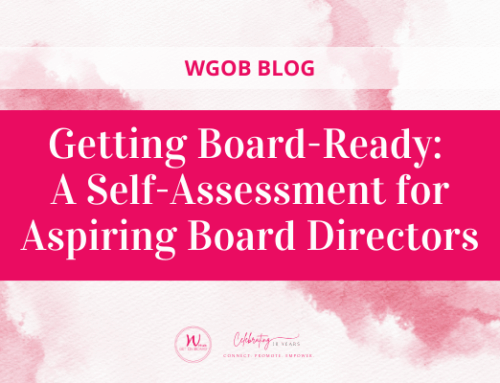Inclusion is the key to unlocking the power and benefits of diversity on corporate boards. That’s why it’s critical for boards to consider how they are ensuring diverse voices and perspectives are meaningfully contributing to decision-making.
To explore this topic in depth, Women Get On Board Inc. (WGOB) hosted a fireside chat on Board Culture: Inclusive Boards on September 14, sponsored by McGlashan Consulting.
Deborah Rosati, FCPA, FCA, ICD.D, GCB.D, CCB.D, Corporate Director and WGOB Founder and CEO, kicked off the event by introducing the two speakers:
- Shona McGlashan, Principal, McGlashan Consulting
- Margie (Madhuri) Parikh, Board Director and Principal, On Governance
To frame the discussion, Shona began with a key clarification.
“We’re not here to make the case for board diversity and inclusion,” she said. “We know that diverse and inclusive boards make better decisions that lead to better organizational outcomes, including better return on investment, more sustainable decision-making, and more innovation.”
Instead, she explained, the goal of the discussion was to focus on how. How do you make boards more inclusive? What are the tactics that you can employ to make the boardroom a more welcoming space for the people around the table?
What do we mean when we talk about diversity and inclusion?
Shona and Margie offered key insights into the distinction between diversity and inclusion in the boardroom, providing a foundation for the subsequent discussion.
Diversity is about representation; it describes who is invited around the boardroom table. Inclusion, however, is the act of ensuring that everyone at the table can fully participate in the discussions and decision-making that happen in the boardroom. It’s through inclusion that everyone in the boardroom is able to share their unique perspectives and experiences, a process which improves discussions and ultimately benefits the organization.
“Inclusion is the superpower that unlocks diversity,” explained Shona.
But what makes a boardroom truly inclusive? An inclusive board:
- Welcomes and celebrates differences
- Ensures that all board members are equally engaged and invested
- Shares power and collective accountability for the board’s work, the organization’s mission, and its purpose
How do we know that boards aren’t as inclusive as they should be?
The data tells the story. According to Deloitte, only 20% of C-suite executives feel that their organization is inclusive.
Not sure how to tell if your board is struggling with inclusivity? Margie outlined notable signs that a boardroom isn’t welcoming to everyone. Many members are afraid to speak. You notice that dissenting behaviour is dismissed or shut down. Some members—especially those who don’t look like everyone else in the room—are often seen second guessing themselves.
While everyone may feel a little on edge or out of place during their first day on a board, certain groups face additional barriers that make it more difficult to succeed and feel included.
“For example, we know that women speak less in meetings and are interrupted more. It’s doubly true for racialized women,” said Shona.
When those barriers build up, it prevents board members from fully participating in key boardroom discussions, sharing their insights, and influencing decision-making.
What are the first steps to creating an inclusive boardroom?
Margie recommends approaching inclusivity by first examining the culture of the organization—particularly the board.
“By taking a look at the culture and saying, ‘What kind of people would be attracted to this?’ we can highlight where we might have gaps,” she said.
Before you can take steps to change the culture of an organization, particularly at the board level, it’s critical to understand the barriers preventing inclusion.
The next step is to discuss what inclusion means, and what it looks like for your board. This step is necessary to begin to build buy-in from everyone—which, Margie noted, is something that doesn’t usually happen right away. Shona also observed that part of this step is ensuring members don’t feel threatened by the idea of inclusion, instead framing it as an opportunity to uplift others.
What are the challenges that prevent inclusion in the boardroom?
A common concern expressed by board members is that diversity can create disruptions to the flow of meetings. Especially at the board level, where maximizing efficiency and following protocol is highly prized, any kind of difference can be seen as disruptive. However, while it’s true that inviting new ways of thinking and decision-making may cause inefficiencies, it’s been shown that if a board is willing to accept the disruption and embrace difference in the boardroom, that’s when the benefits of diversity appear.
Similarly, pre-existing social status may influence attitudes in the boardroom. For example, a new CEO might join the board as a previous CEO and be offered more deference than other board members due to their perceived status. Boards can address this issue by acknowledging it and ensuring that everyone in the room has equal time to contribute, regardless of their background.
Training on unconscious bias can help boards navigate inclusion challenges, and so can other small steps at an individual level. For example, board members can focus on taking care to avoid references, language and jokes that may not translate across groups and cultures.
What tactics can boards use to improve inclusivity?
Everyone in the boardroom has a role to play in fostering inclusion, although the chair should play a leading role.
To encourage inclusion, boards should focus on building psychological safety, which is the felt permission to be yourself, to contribute openly and to express yourself with candor. Psychological safety is essential in the boardroom because good governance hinges upon creating the optimal conditions for effective decision-making. When everyone in the room feels safe to express themselves and share their insights, it results in better outcomes for the organization.
Shona outlined four questions to think about when working to create psychological safety:
- Are you giving everyone clarity about the desired outcomes?
- Does everyone have the autonomy and agency to reach that outcome in a way that makes sense to them?
- Does everyone have a manageable workload?
- Are you allowing people to challenge others and express different perspectives?
Margie also noted that the actions of the chair are the single factor that makes the greatest impact on boardroom culture. When the chair is welcoming at the outset and takes steps to ensure that everyone has the opportunity to contribute, that’s when a boardroom feels truly inclusive.
Another tactic she recommends is a buddy system, pairing newer board members with more seasoned ones. Because research shows that mentorship programs tend to favour people who are already privileged, your board’s buddy system should intentionally focus on supporting more marginalized members. The new member should be encouraged to ask their buddy questions, and there should be specific time set aside following each meeting for the pair to debrief.
Additionally, chairs should ensure that they are building personal connections with each member of the board through one-on-one conversations and meetings. These discussions are opportunities to get more comfortable, ask questions, get feedback, and get to know each other.
“When you’ve had those comfortable conversations and experiences with each other, you feel safer to speak out,” said Margie.
Similarly, social gatherings between board members can foster a sense of inclusion and belonging by helping everyone learn more about each other. Board members can also foster inclusion in the boardroom in what Shona calls “micro-affirmations,” such as acknowledging the contributions of others and amplifying the voices of their marginalized colleagues.
Margie offered one final tactic, which she calls a “dissent agenda.” It’s the practice of allowing negative opinions to surface and circulate without dwelling on, critiquing or clarifying them. You can even designate someone whose job is to dissent and rotate that role. This activity can be helpful for making important decisions because it ensures that all the possible risks are brought to the table.
To take advantage of the full benefits of a diverse board, it’s vital to foster a sense of inclusion, ensuring that every member feels safe expressing their opinions and contributing to discussions. By adding these tactics to your boardroom toolkit, you can take the first steps toward creating a more inclusive—and, in turn, effective—boardroom.






